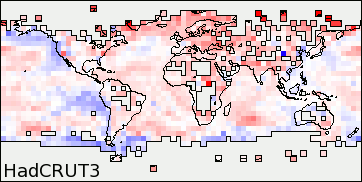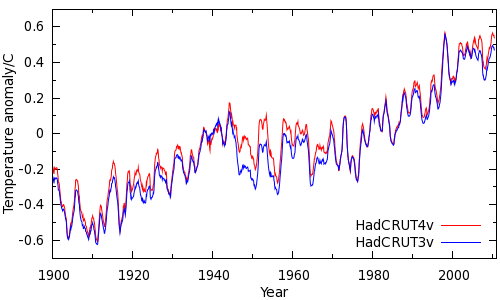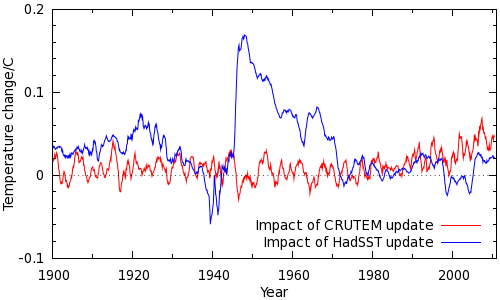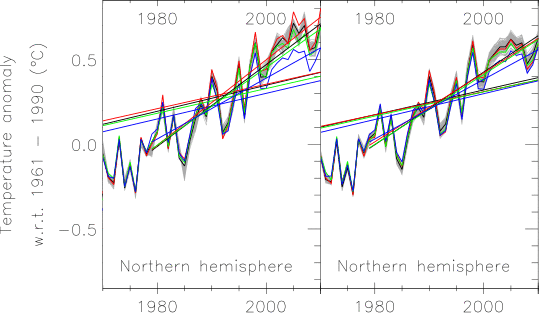
The Hadley Centre of the UK Meteorological office and the Climatic Research Unit (CRU) of the University of East Anglia have since 1989 jointly maintained a global surface temperature record, HadCRUT. The current version of this record, HadCRUT3, is very widely cited in the academic literature (currently around 900 citations), and provides a record of combined land and ocean temperatures running back to 1850. The dataset is updated monthly to provide a continuous snapshot of the state of the climate.
Recently a new version of the record, HadCRUT4, has been released running to December 2010, with monthly updates planned in future. This update is a response to several factors. In the case of the CRUTEM land temperature record, coverage has been declining because of the need for current weather stations to have a sufficient number of readings in the baseline period 1960-1990. As weather stations move, continuity back to this period is lost. The impact of this decline in coverage has been assessed by two reports, by the ECMWF and GISS, and also reproduced here, and has led to an underestimation of recent land temperature trends. The CRUTEM4 update introduces a number of new station records to address this coverage issue.
A second motivation for the update is the discovery of a bias in the sea surface temperature record, HadSST2, leading to a significant cool bias following the second world war. A new version, HadSST3, addresses this bias, but also has some impact on recent temperature trends. HadSST3 also introduces a new approach to estimating uncertainties in temperature records through the use of an ensemble of realisations; this approach is carried through to HadCRUT4.
The method and results are described in Morice et al (2012). In this article we will examine the impact of these changes on the global surface temperature record and consider the implications for other datasets.
Figure 1 shows a comparison of the change in temperatures over recent years in HadCRUT3 and HadCRUT4, using the difference between the 5 year means 2006-2010 and 1996-2000, and showing the change in coverage. Note that the rectangular projection used here exaggerates area at high latitudes. (The temperature scale ranges from +2C (red) to -2C (blue).

Most obvious is the improvement in land coverage, with many fewer gaps in coverage in the high Northern latitudes, which are mostly warm (red cells). More subtle is a slight increase in sea surface temperatures, spread across the whole globe - this can be seen in many sea cells becoming marginally more red or less blue. Both these effects tend to increase the 15 year trend, although the relative size of the effects is not apparent from this figure. We will examine their relative contributions shortly.
What is the impact of these changes on the instrumental temperature record? Figure 2 shows a comparison of HadCRUT3 and HadCRUT4, using a 12 month running mean.

The big difference is the near-elimination of the temperature drop after the second world war, as a result of the corrections introduced in HadSST3. The recent changes are rather smaller, but there is a noticeable increase in temperatures since the late 90's.
Where do the differences come from? This question can be answered by separating out the contribution of the changes to CRUTEM and HadSST. Since Hadley and CRU distribute gridded datasets for the land and ocean data, they can be combined in any combination using a land mask to select between land and ocean series, or to perform a weighted average in the case of coastal cells - this is the method employed in constructing the HadCRUT4 combined maps (HadCRUT3 used a slightly different approach for coastal cells). Combining CRUTEM3 and HadSST2 give a very close approximation to HadCRUT3, and CRUTEM4 and HadSST3 give an almost exact reproduction of HadCRUT4. (This also reveals that additional corrections incorporated into HadCRUT4 have minimal impact).
By also calculating an intermediate series, using the new CRUTEM4 and the old HadSST2, and taking differences with the HadCRUT3 and HadCRUT4, we can separate the contributions of the new land and sea surface temperatures. The results are shown in Figure 3 using a 12 month moving average.

The differences are exactly what we would expect from our examination of CRUTEM4 and HadSST3 - the changes are very similar to the changes in the land and sea records respectively, scaled down by the proportion of the globe covered by each (or rather the proportion sampled).
The biggest difference arises from the change in the sea surface temperatures after the second world war. As we saw previously, at the end of the war there was a switch from using warm-biased engine room intake (ERI) temperatures back to using cool-biased bucket measurements - shown on the right. (The switch from buckets to ERIs at the beginning of the war was already corrected in existing records.) This known but previously uncorrected cool bias required an upward adjustment to the post-war sea surface temperatures.
Land temperatures estimates over the past two decades have increased in the new series owing to improved coverage of the fastest-warming high Northern latitudes. This change is solely due to the inclusion of additional data, rather than any change in methodology (since the issue of averaging conventions described in the previous article does not apply to global data). Recent sea surface temperatures have also seen a small upward adjustment owing to a continuing transition from warm-biased engine room intake measurements to buoy measurements over this period, arising from the new bias correction.
Given that recent temperature trends are a topic of significant public interest, we will examine them in detail. The following table shows the HadCRUT3 and HadCRUT4 trends over the 15 year period 1996-2010, as well as the 13 year period starting in the year 1998, since that year is often used as a starting point for recent trends. The contributions of the land and sea changes have been separated out.
| Dataset | Trend 1996-2010 | Trend 1998-2010 |
| HadCRUT3v | 0.098 °C/decade | 0.020 °C/decade |
| +CRUTEM change | +0.20 | +0.24 |
| +HadSST change | +0.18 | +0.39 |
| HadCRUT4v | 0.136 °C/decade | 0.083 °C/decade |
The contribution of the two updates to the trend from 1996 is roughly equal. The change in trend since 1998 is more strongly affected, with the 1998/1999 surface temperatures receiving a significant downward adjustment in both the land and sea surface temperature records. (The whole record is then shifted upward due to temperature changes in the baseline period.)
HadCRUT3 was always an outlier amongst the surface temperature records for its high 1998 temperature, so this change brings HadCRUT4 more into line with the other versions of the instrumental temperature record. The change in the land temperature record was expected due to the change in coverage. The impact of the bias correction to the SST data on the 1999 temperature was more of a surprise.
HadCRUT4 provides an ensemble of temperature series to allow trend uncertainties to be calculated which take into account the effects of correlation in the bias corrections. This approach, described in our examination of HadSST3, is an additional source of uncertainty not accounted for by post-hoc uncertainty estimates such as that employed in the Skeptical Science trend calculator. Assuming that the two sources of uncertainty are uncorrelated, they can be combined using the RMS (root-mean-square) of the individual uncertainties. Trend uncertainties calculated using this approach are tabulated below.
| Trend period | 1996-2010 | 1998-2010 |
| Uncertainty from ensemble | ±0.017 °C/decade | ±0.029 °C/decade |
| Uncertainty from trend estimation | ±0.145 °C/decade | ±0.172 °C/decade |
| Combined uncertainty | ±0.146 °C/decade | ±0.174 °C/decade |
In this case of the recent trend calculations the additional uncertainty due to correlated errors in the bias correction is small. This is likely to be true for most recent trends.
One other innovation in HadCRUT4 is the use of the NCEP/NCAR reanalysis dataset to determine the additional uncertainty in the global mean temperature arising from incomplete coverage. The effect of coverage is simulated in the NCEP data by reducing the coverage to match a given month from the HadCRUT4 data, and seeing how the estimated global temperature changes. Results from every month in the NCEP data are combined to determine an uncertainty estimate for each month in the HadCRUT4 record.
The HadCRUT4 record can be compared to the other land-ocean temperature records using the tools from Wood for Trees, Nick Stokes, or Skeptical Science. (Unlike the CRUTEM4 case the impact of averaging conventions is minimal for the land-ocean data, so the distributed records are comparable.)
Morice et al (2012) make an interesting comparison to other datasets in their Figures 11 and 12. Excerpts from these figures are shown in Figure 4, showing the recent Northern hemisphere temperatures in which the disagreement between the different records is greatest. The curves are HadCRUT4 (black), GISTEMP (red), NCDC (green) and JMA (blue). The grey region is the HadCRUT4 uncertainty interval, and the straight lines are 1979-2010 trends. The left hand figure compares global surface temperature, showing the disagreement between the datasets. The right hand figure is a comparison of temperatures calculated only over the regions where all the datasets have coverage: This is a test previously performed by Hansen et al (2010), which we reproduced here. As with the previous studies, they find that the principal difference between the datasets is due to differing coverage - over the regions where the datasets share coverage they are in good agreement.

An interesting question is how the HadCRUT4 update will influence the temperature records from other groups. The CRUTEM4 update is not relevant to the other datasets, since the main change has been to increase coverage. The NASA and NCDC datasets already had significantly better coverage than CRUTEM3.
The HadSST3 update may affect the other records directly or indirectly. GISTEMP uses sea surface temperature data from HadISST, which incorporates data from HadSST2. If HadISST is updated to use HadSST3, then GISTEMP will be affected accordingly. The NCDC record uses NOAA’s ERSST ocean data, and so will not be affected directly. However it is likely that NOAA will examine the work of Kennedy et al and evaluate whether the biases identified in that work are correct.
HadCRUT4 integrates updated versions of the CRU land-temperature dataset and the Hadley sea surface temperature datasets. The update to the land surface temperature data addresses a cool bias over the recent years owing to poor coverage at higher latitudes, a well known problem with the CRUTEM3 record.
The update to the sea surface temperatures is more interesting, since it introduces a new bias correction to the SST data which has not been addressed in existing datasets. It will be interesting to see what other experts in the field make of this development. An independent investigation of the SST bias problem using different approaches would help to establish whether the new record is realistic.
Morice et al (2012) reproduce a result previously obtained by the GISTEMP team and others, showing that the bulk of the disagreement between various versions of the instrumental temperature record arises from differing coverage rather than any difference in the data or methods. Over the regions where the datasets share coverage, agreement is good.
In this article and the preceding articles on HadSST3 and CRUTEM4 I have presented an overview of the literature and data. There will be one further article in this series, in which I will present my own comparisons and evaluation of the new records.
Posted by Kevin C on Tuesday, 22 May, 2012
 |
The Skeptical Science website by Skeptical Science is licensed under a Creative Commons Attribution 3.0 Unported License. |